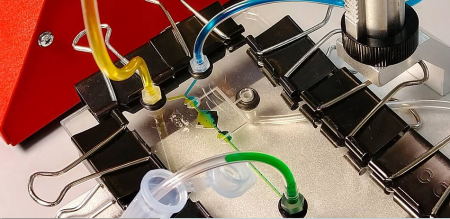THE BOTTOM LINE
By publishing a key protocol in the JoVE Video Journal, a Boston University lab increased the method’s success rate by 25 percent, while reducing the time lost to failed experiments.
THE LAB
Boston University’s DAMP lab specializes in conducting automated, highly scalable, synthetic biology experiments. Each experimental protocol and result must be repeated and rapidly shared with the research community. It’s crucial that the DAMP lab perform its experiments fast and at a reasonable cost, without sacrificing data quality. To support this goal, the lab automates a wide variety of investigative protocols — from DNA assembly to cloning to flow cytometry sample preparation. The lab works with both academic and corporate partners.
THE CHALLENGE

While working on modular DNA devices, the lab members were allowed to improvise their experiments. “Each one of us would perform the same experiment the way we thought was the best,” says DAMP Lab Manager, Marilene Pavan. “Because of that, we had a lot of variation in our results and efficacy of our experiments.”
The lab decided it needed to perform the experiment using the same exact set of protocols. They decided video would be the best format for sharing the protocol. “We thought that being visual with the project would help a lot,” says Pavan. “We want to generate high quality, reproducible results, and we want other labs doing that as well.”
The lab chose to publish in JoVE, the leading producer of scientific video publications.
THE JoVE SOLUTION
In 2017, the DAMP lab published its first JoVE article, on the automated robotic liquid handling assembly of modular DNA devices. Having this video article accessible anytime, anywhere offered multiple benefits, including:
- A boost in the experimental success rate. By relying on JoVE as the single guide to performing an experiment, the lab’s protocol success rate rose from an estimated 70 percent to 95 percent.
- Eliminating unnecessary repeated experiments. Before adopting JoVE, the experiments were more error-prone, notes Pavan who says: “Each mistake cost the lab three more days in experiments. Now, we don’t have this problem anymore. We just use the three days. By adapting this protocol to be used in TECAN and Echo robots, we also saved two hours of hands-on time in pipetting DNA and reagents.”
- Enabling other labs to repeat the experiment. Publishing in JoVE helps the DAMP lab fulfill its core mission of producing reproducible protocols and results. “Because we are working with automation, we thought that the video part would be very important,” says Pavan. “It shows everything that was used for the protocol. It can actually bring other researchers to the point where they can, in their laboratory, get the same results that we were getting in the JoVE publication.”
- Raising the lab’s profile. By sharing the article, the lab can:
- Acquaint new students with the lab and its research.
- Forge partnerships and collaborations at conferences (such as at SLAS 2018).
- Illustrate the lab’s research when applying for grants (as done with the National Science Foundation).
The DAMP lab is preparing to submit its second JoVE article, done with the low-cost liquid-handling company, Opentrons.



